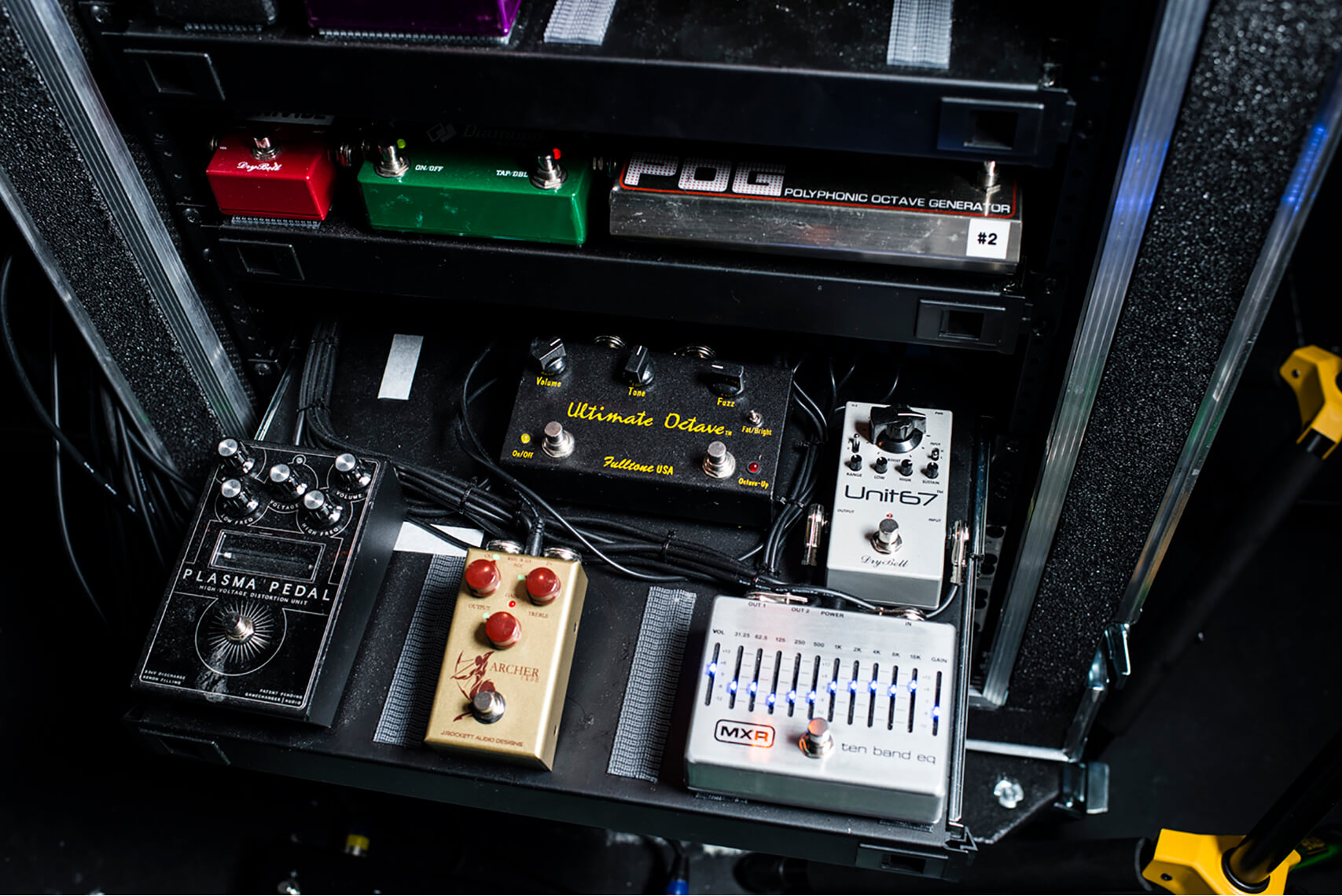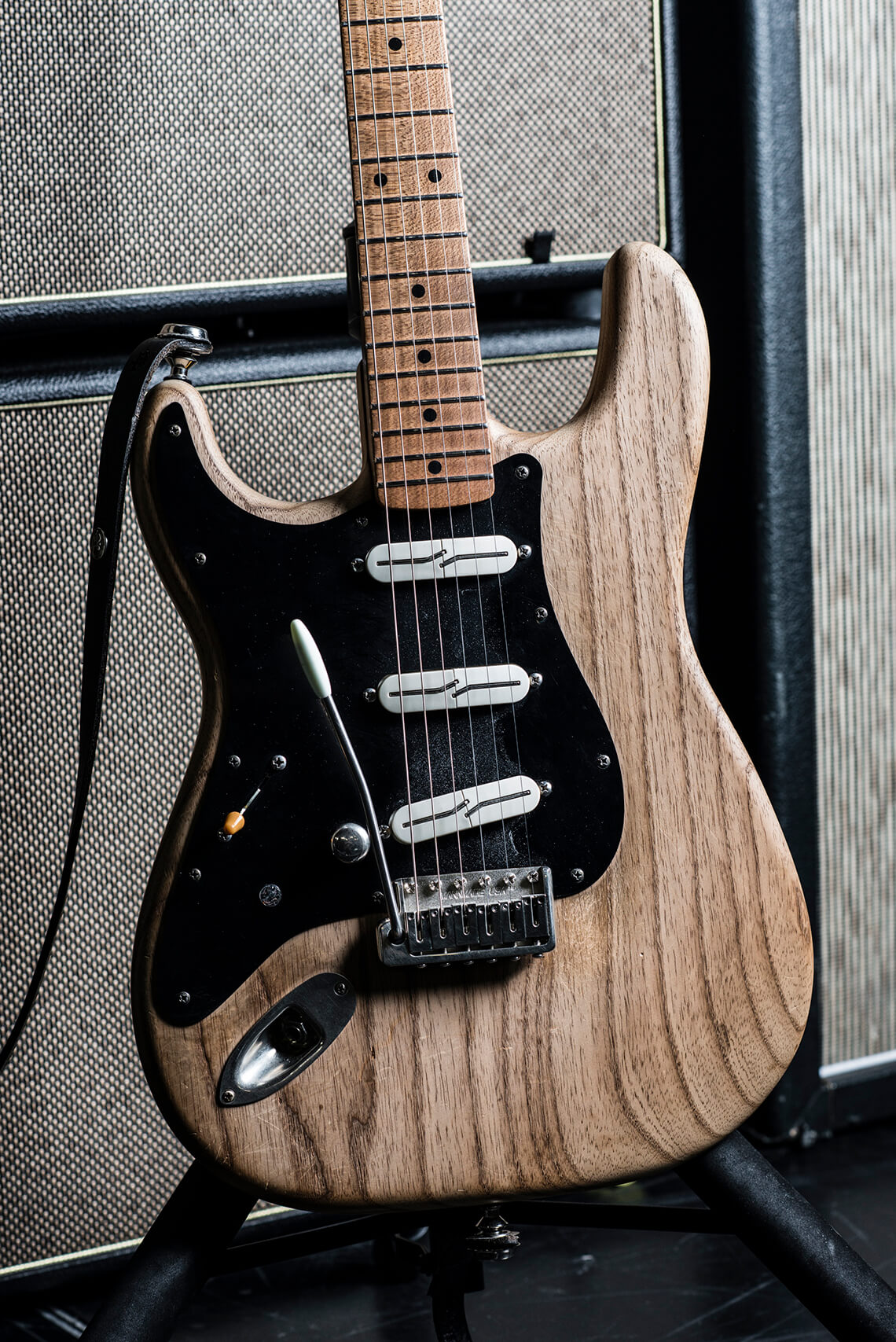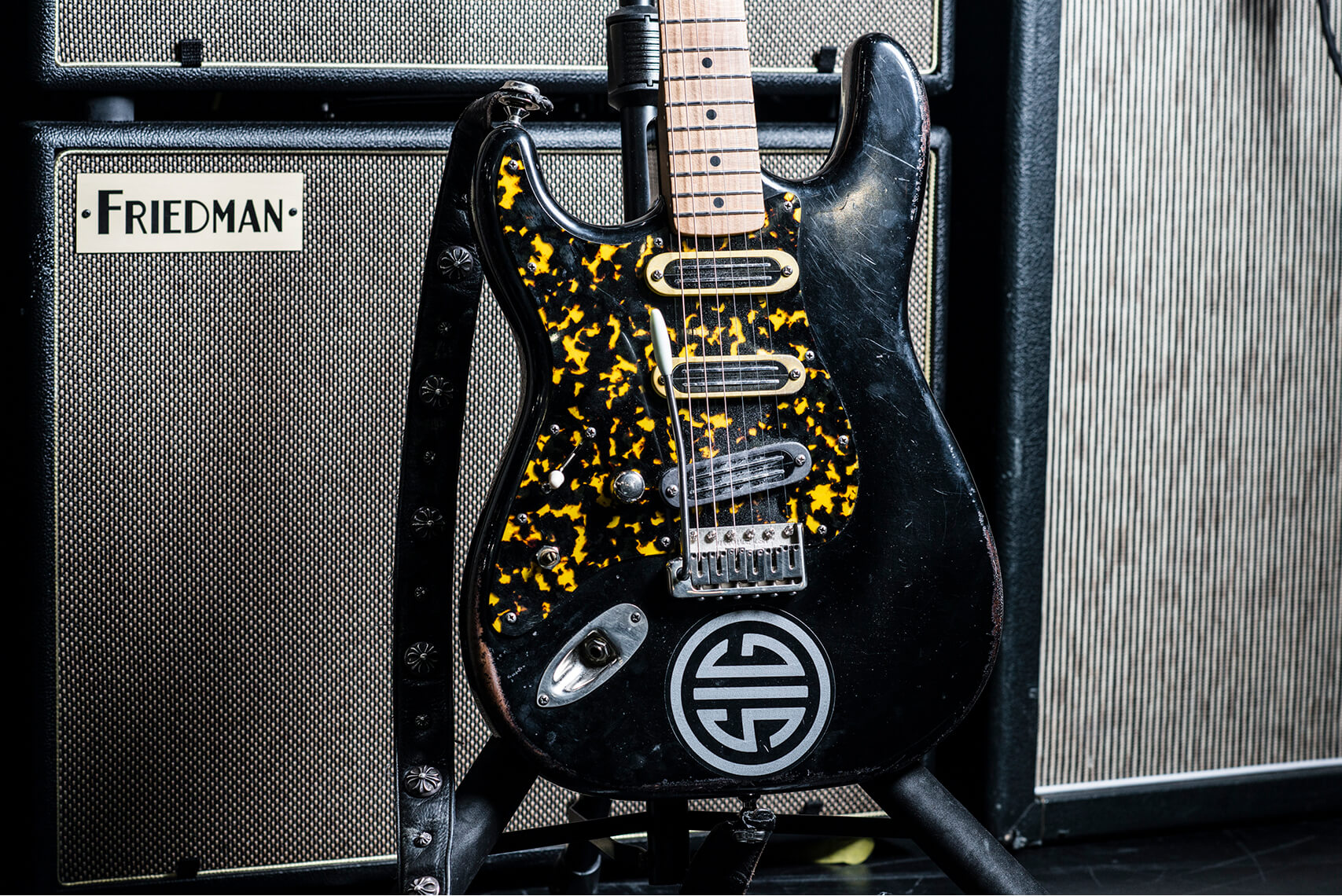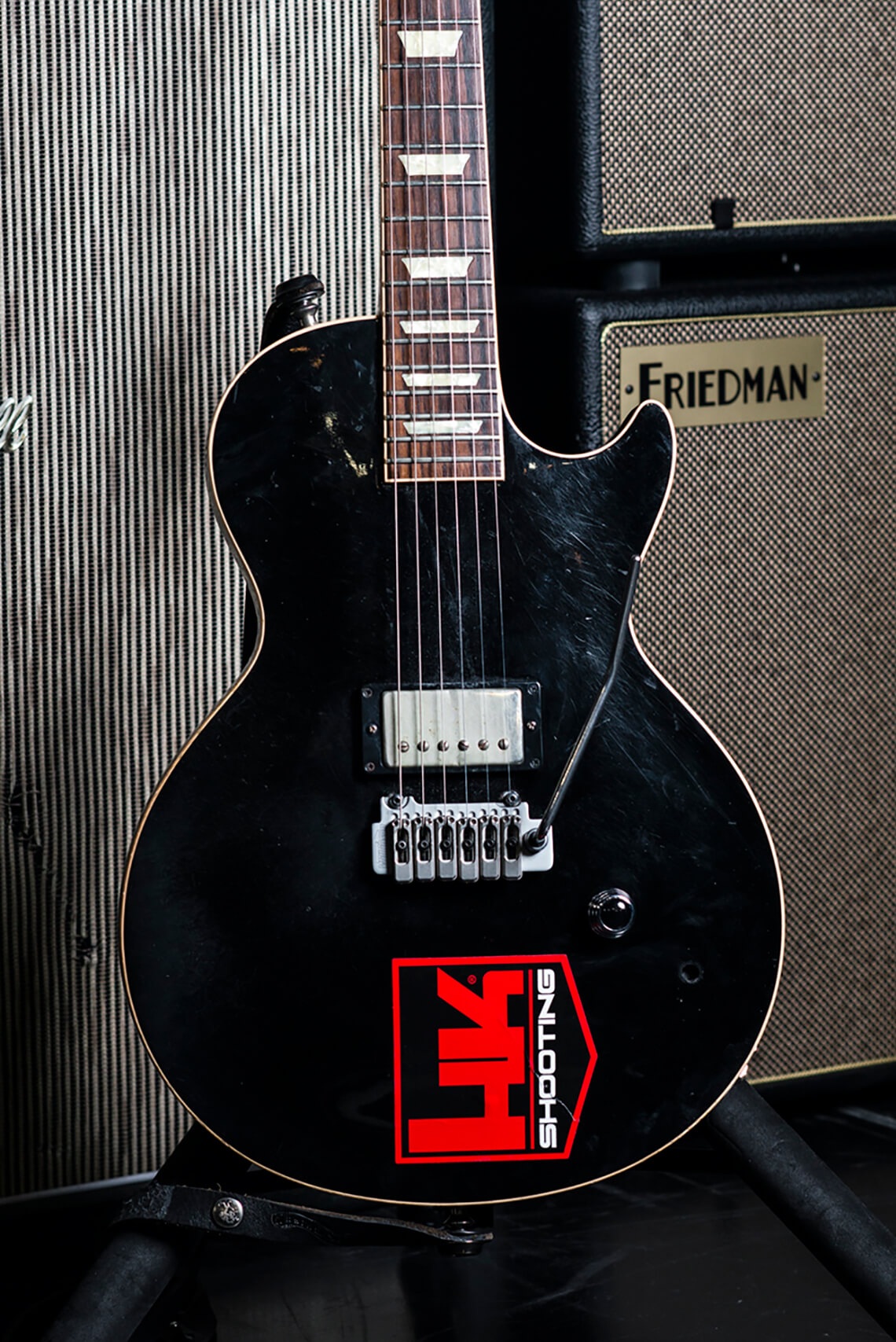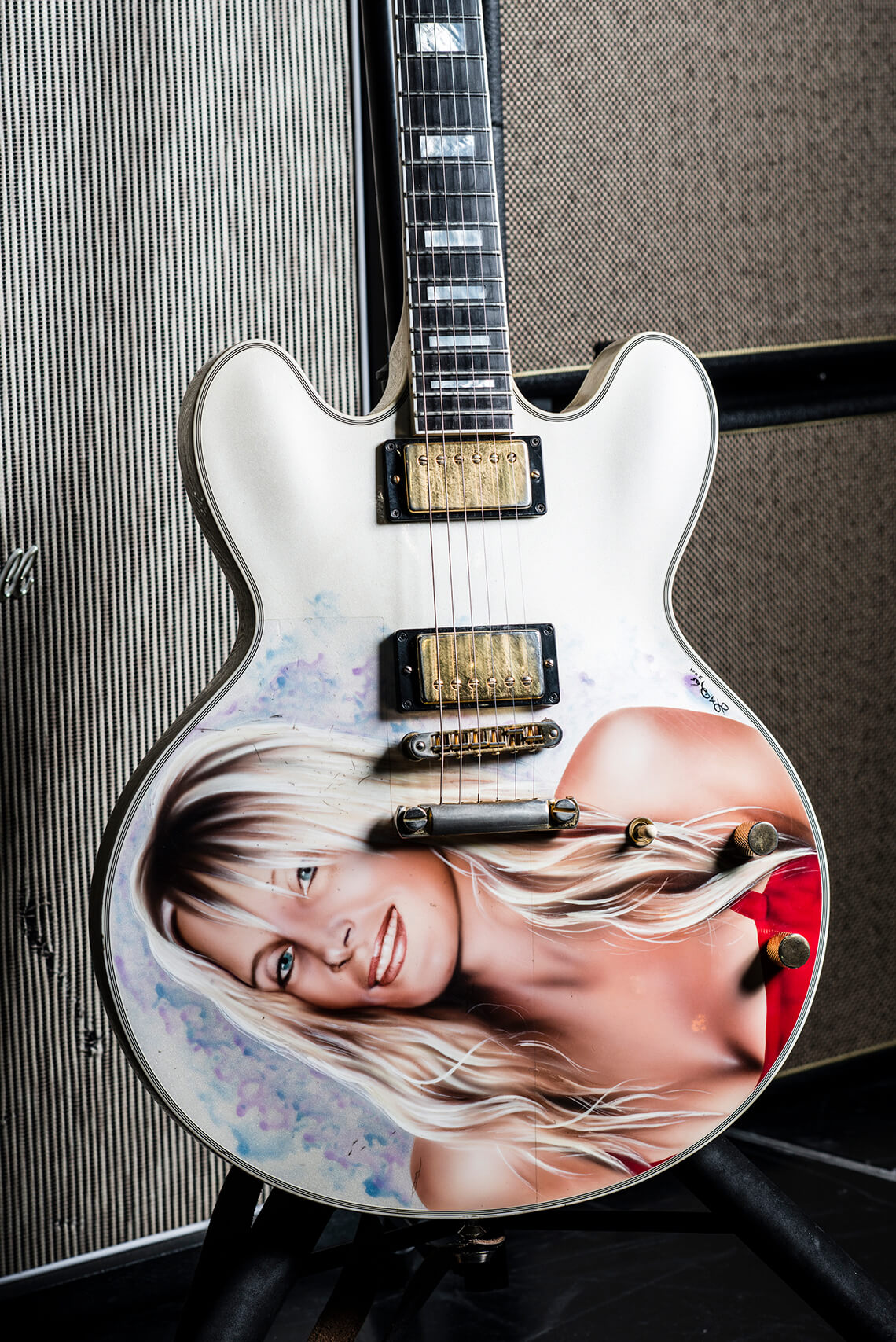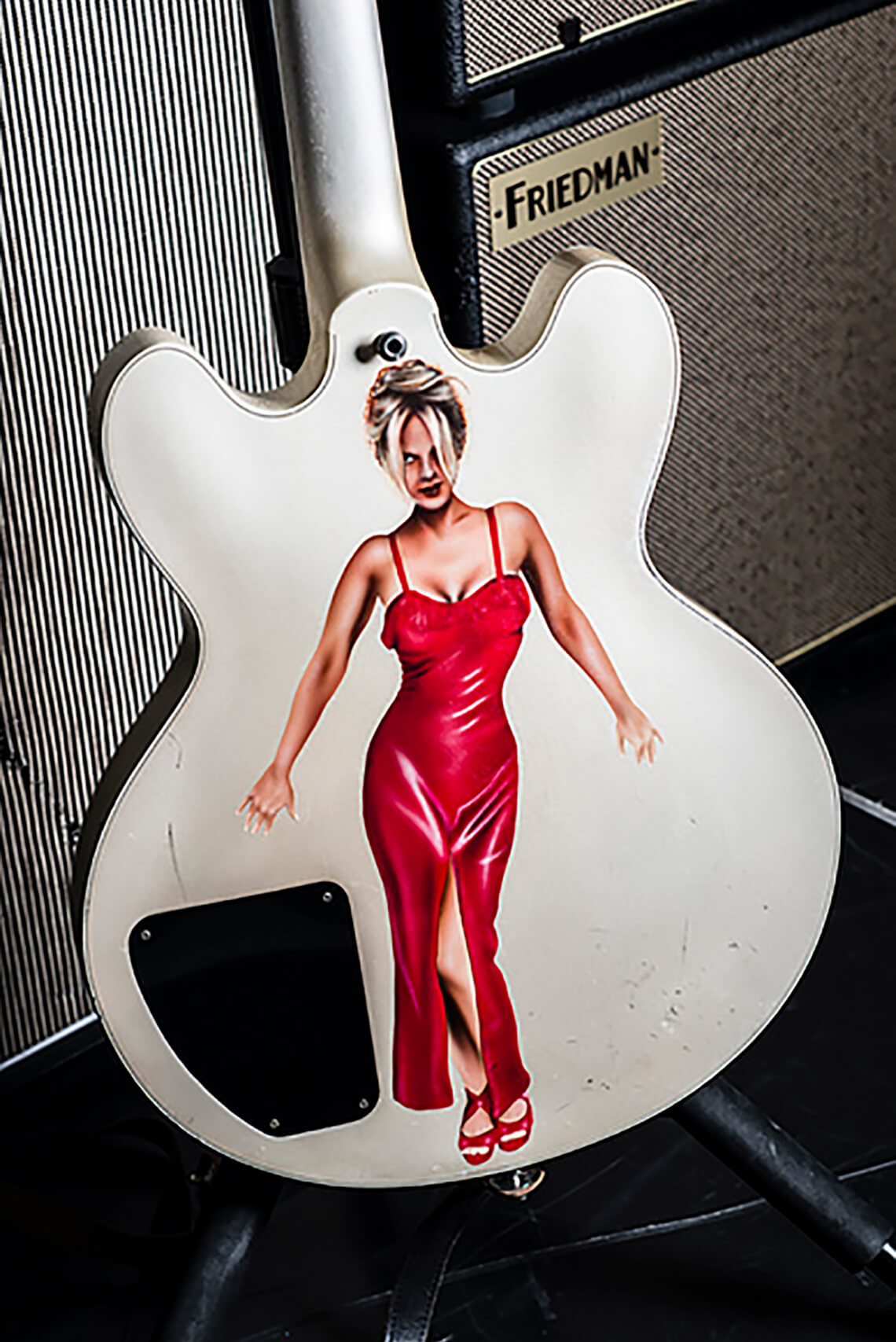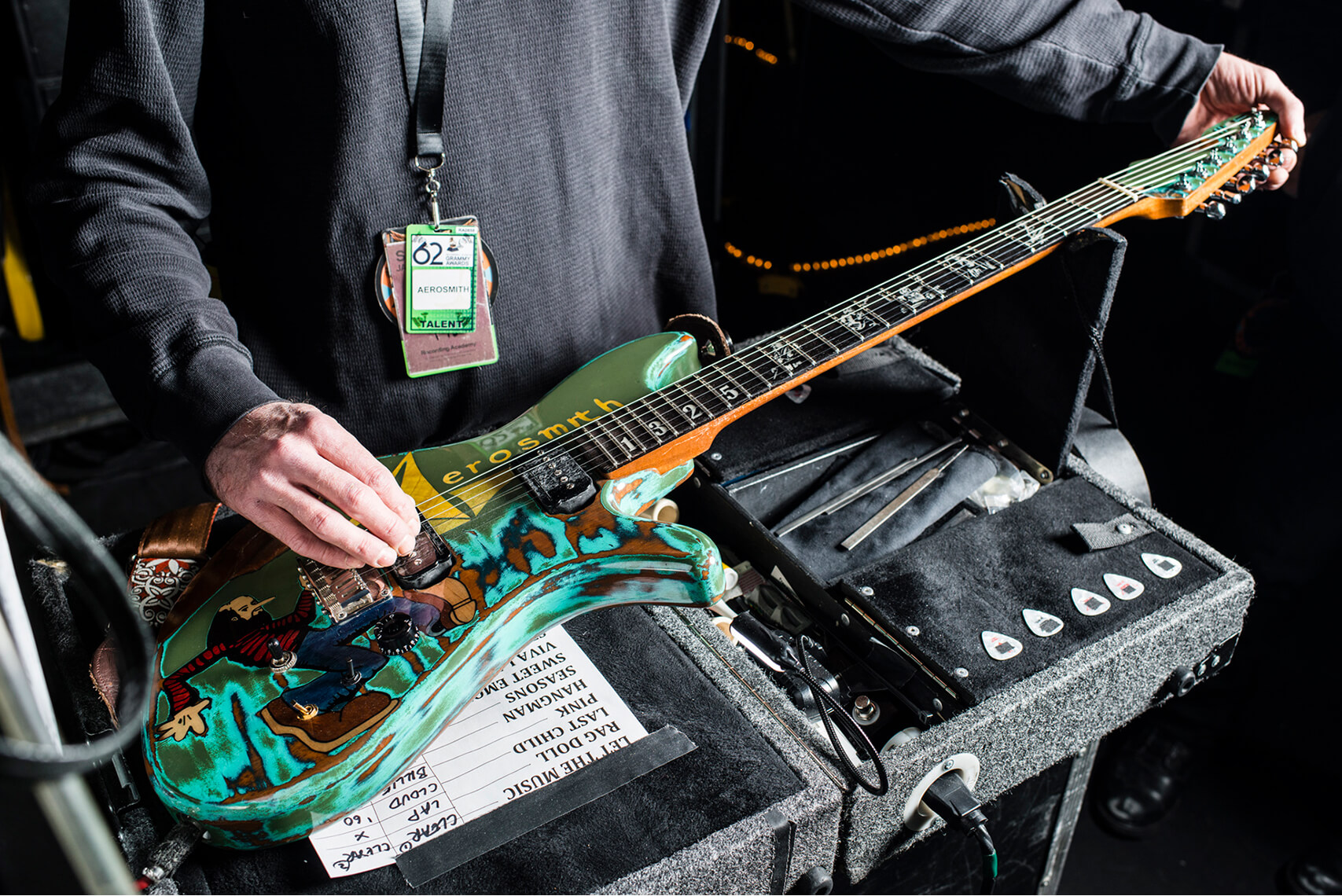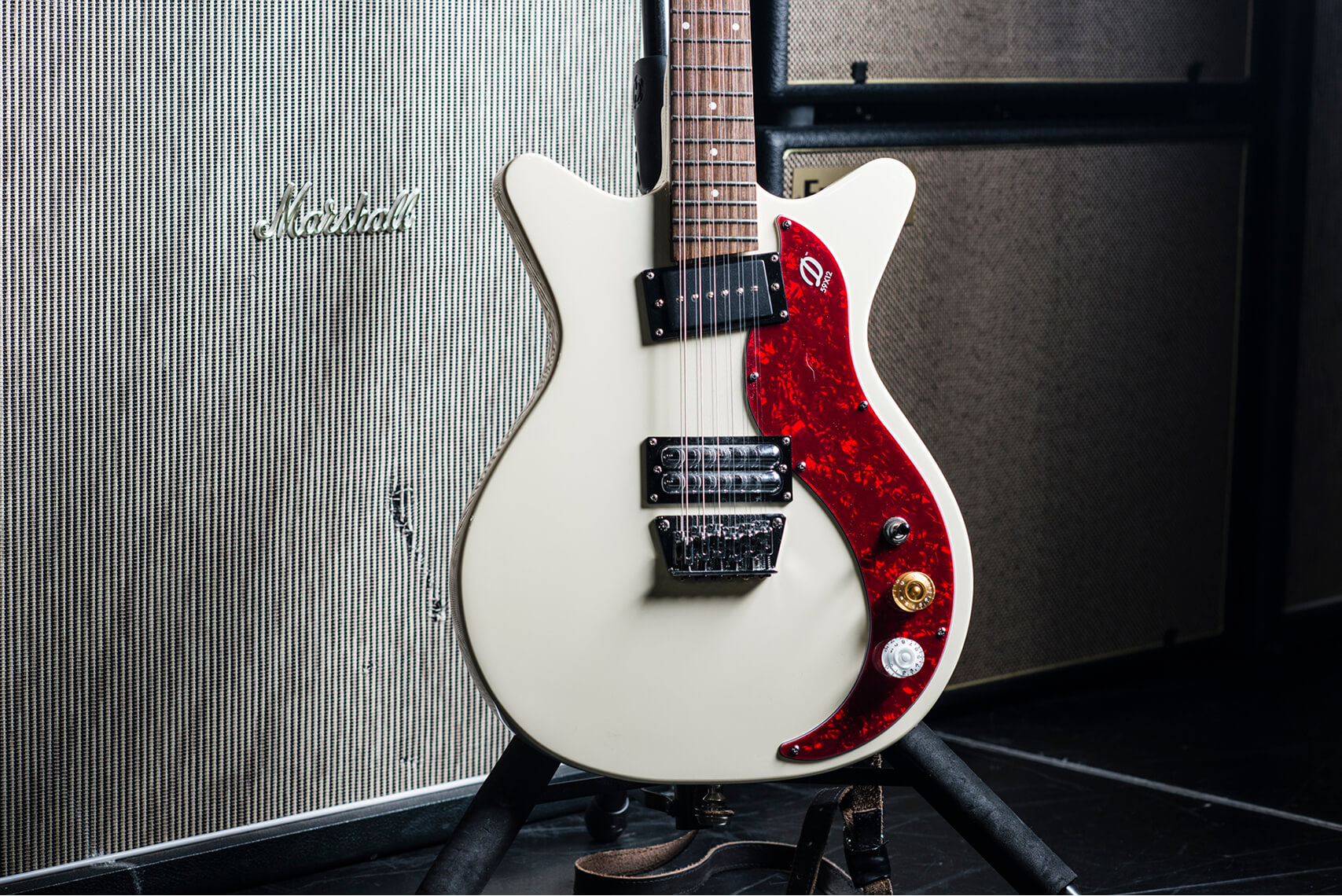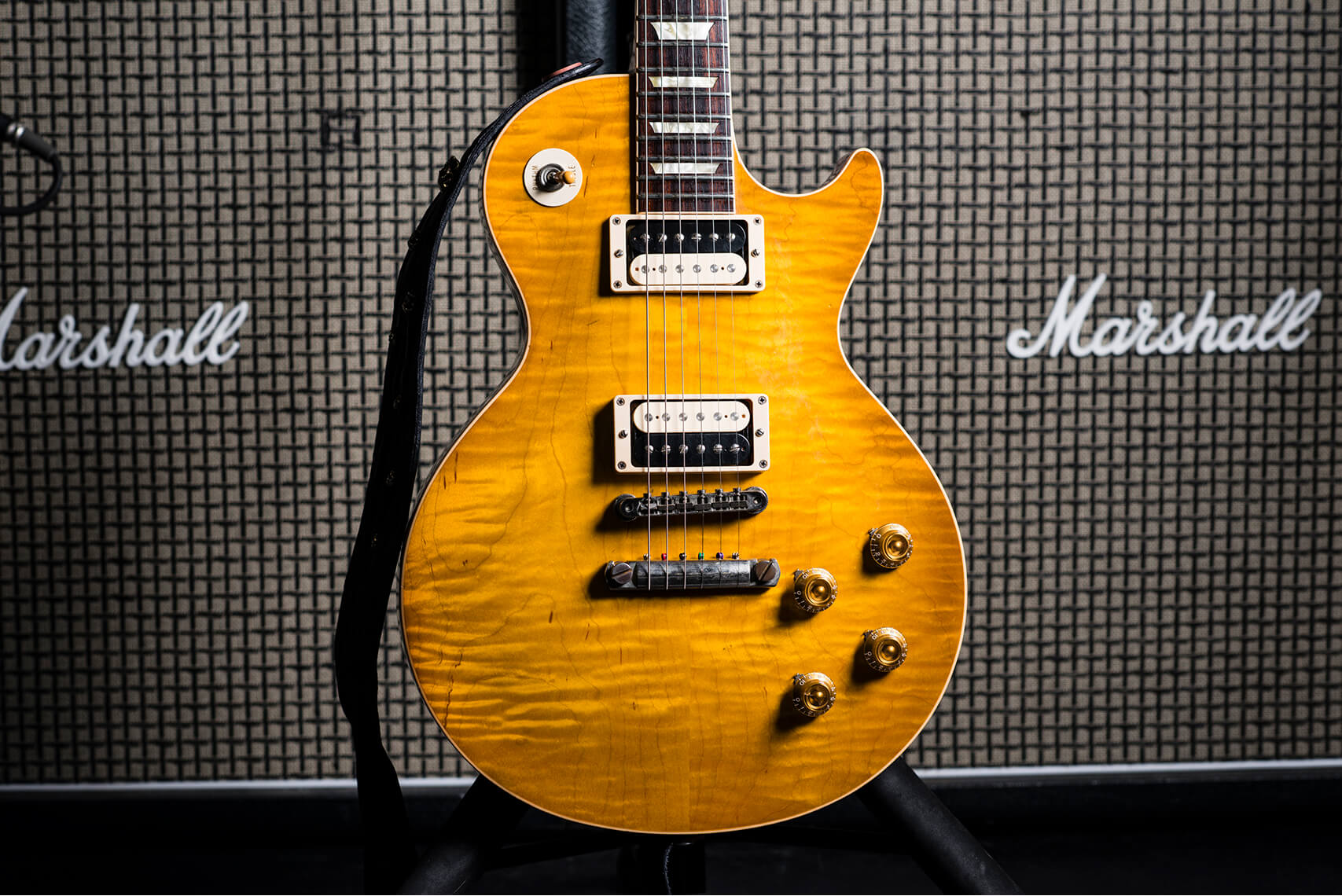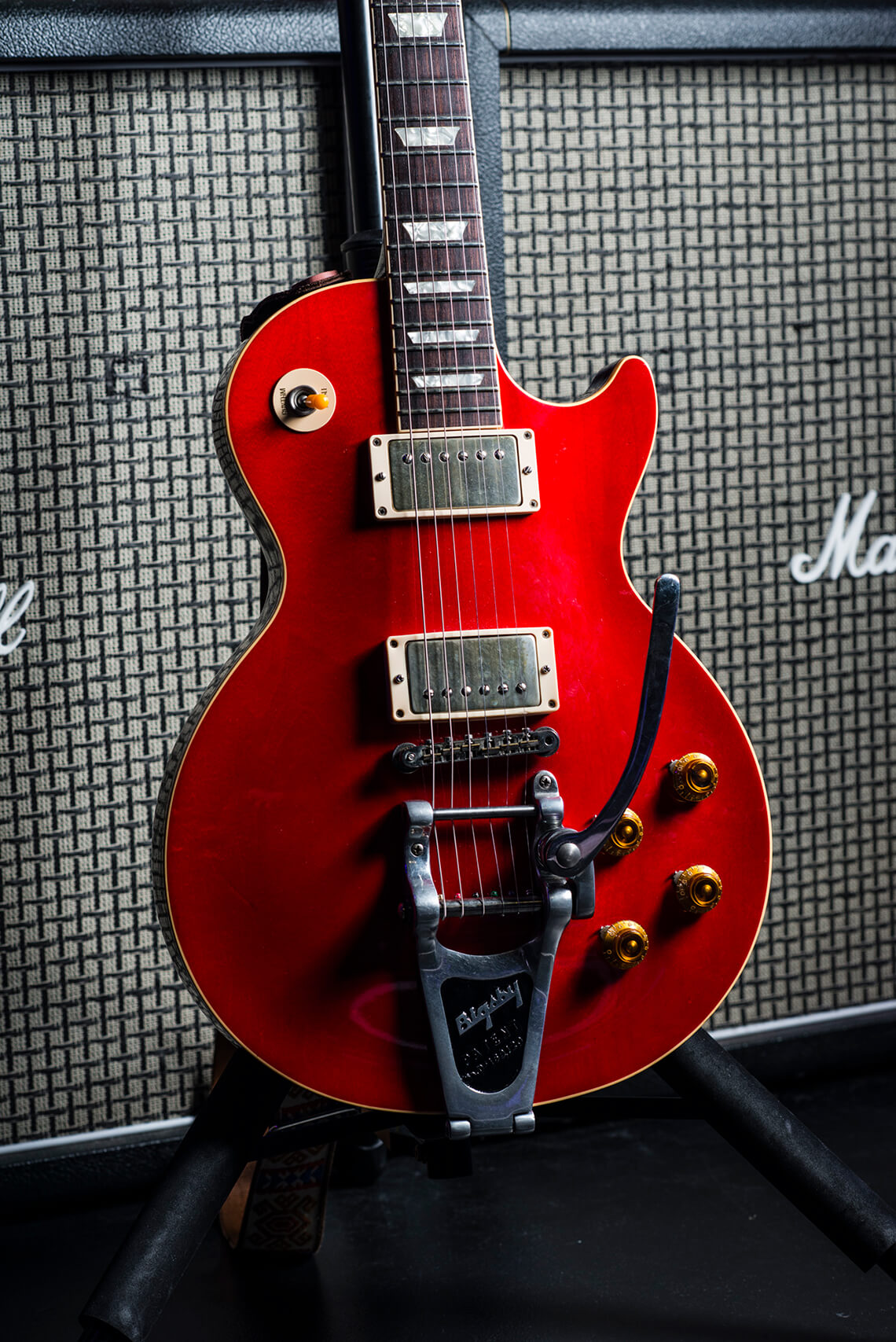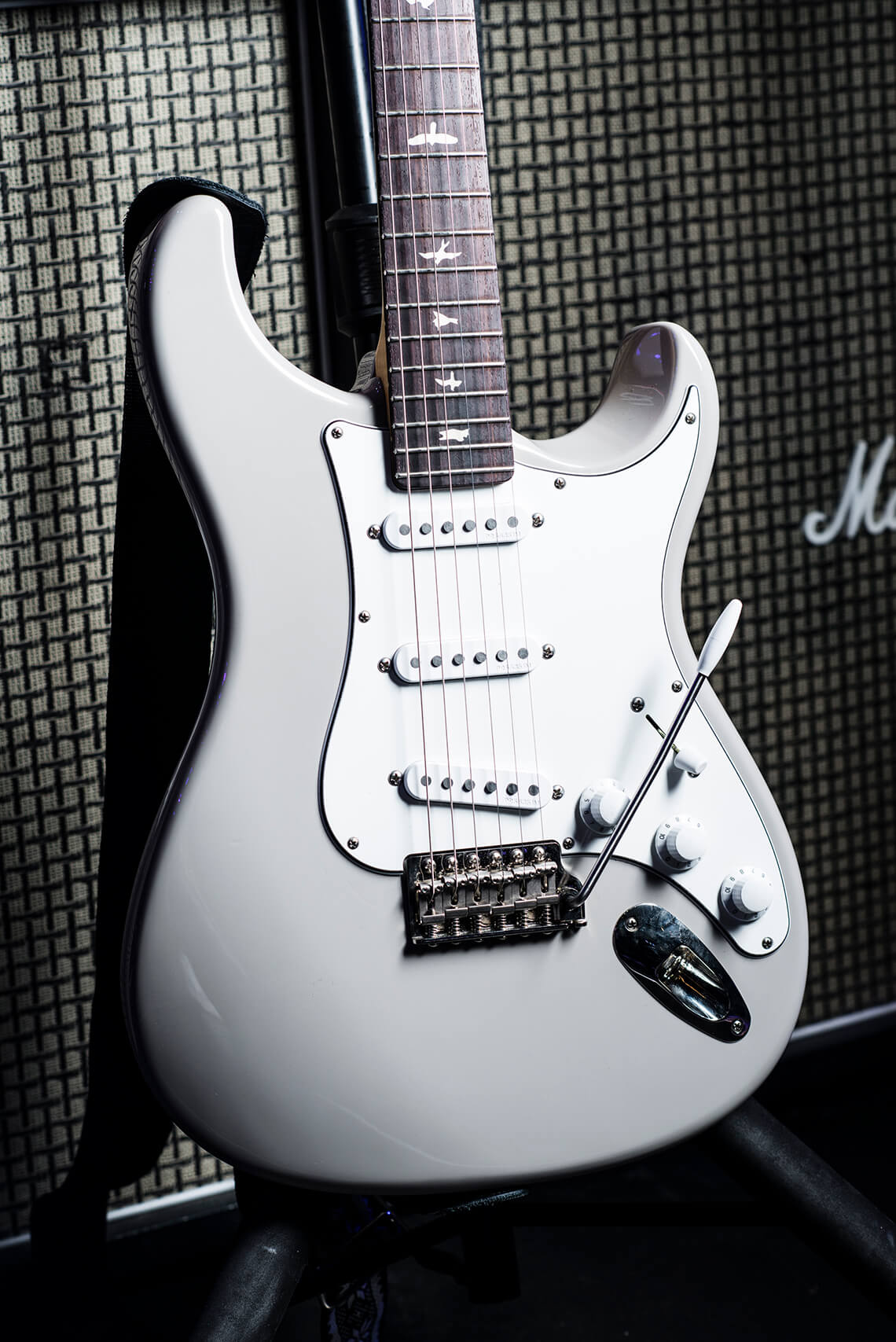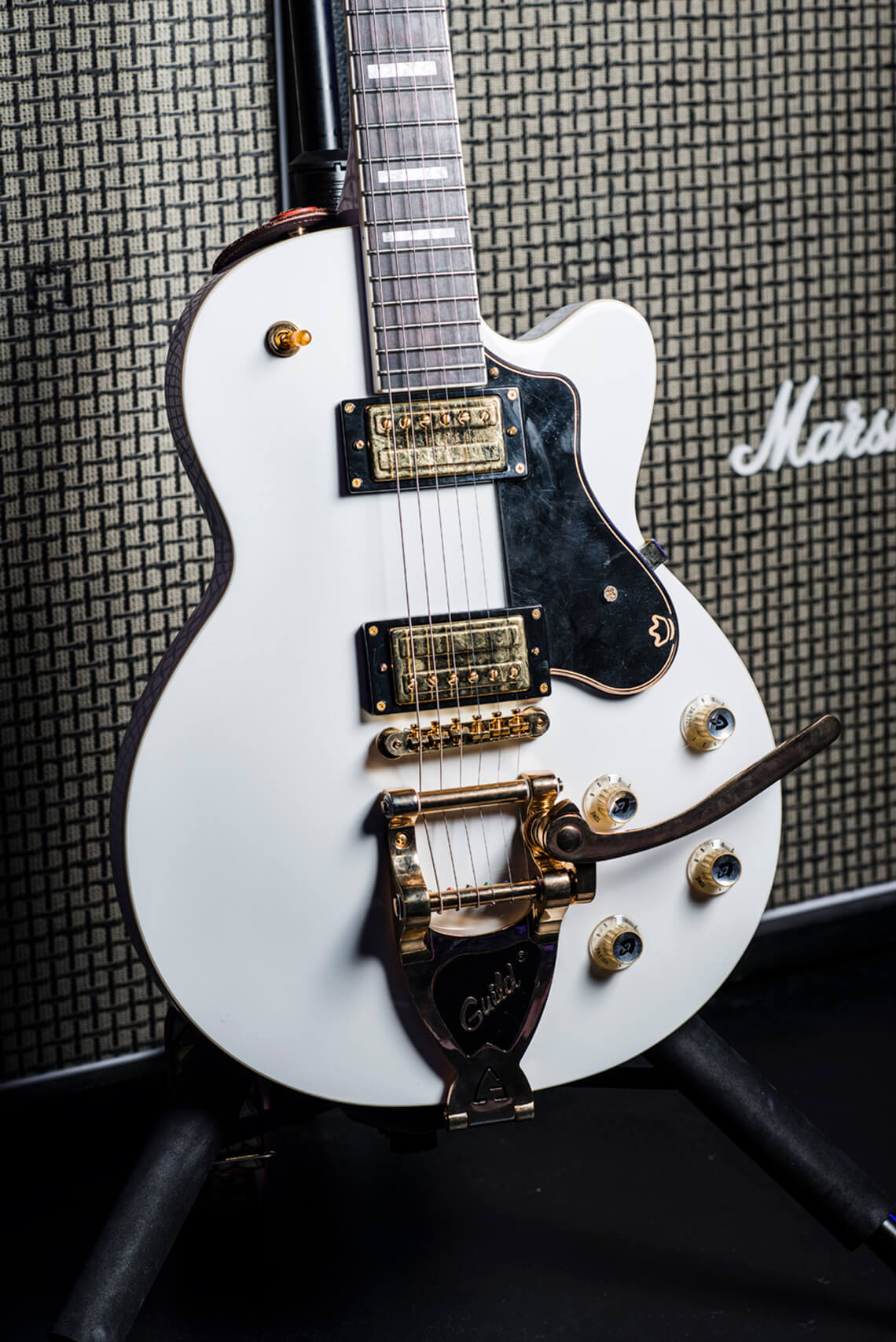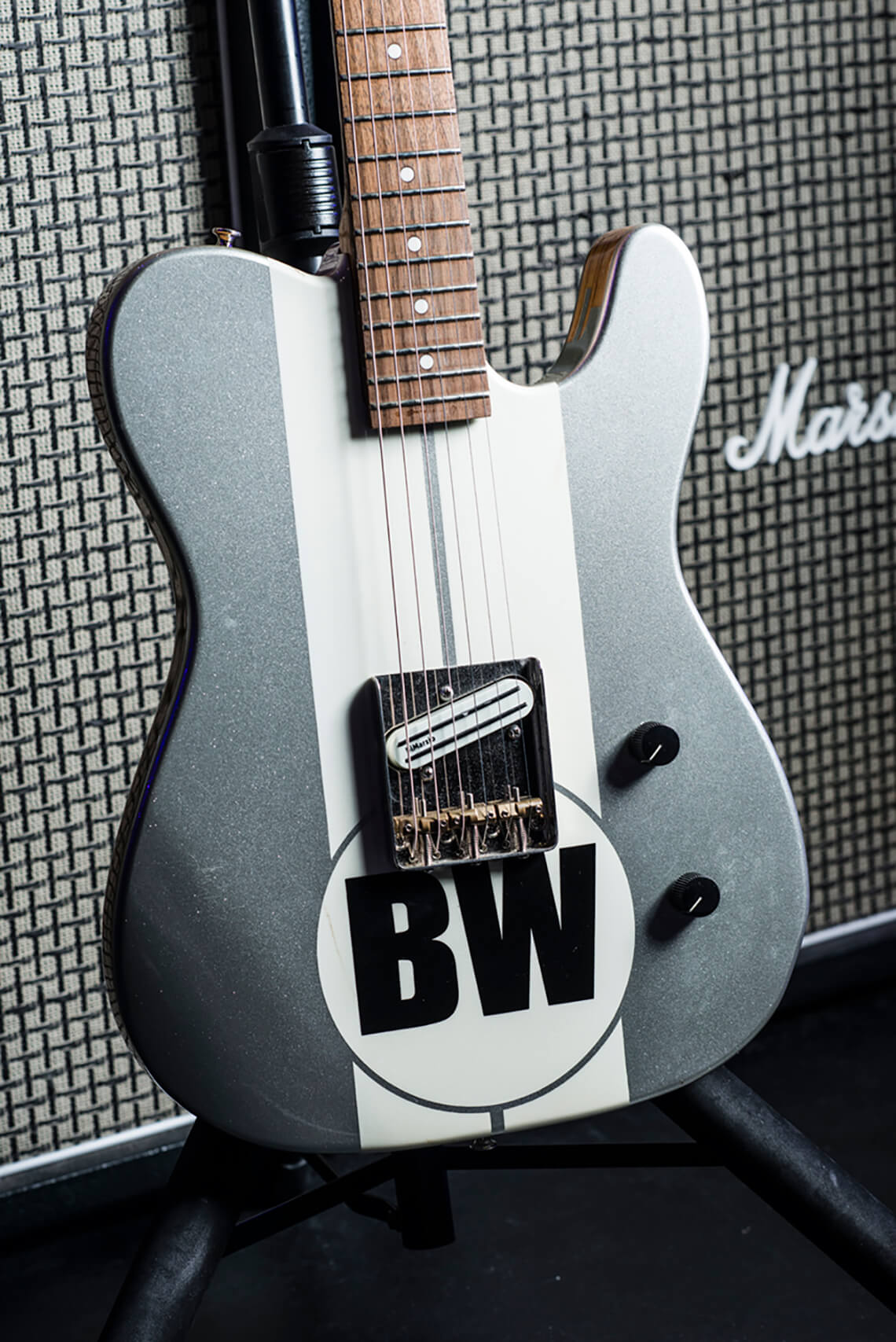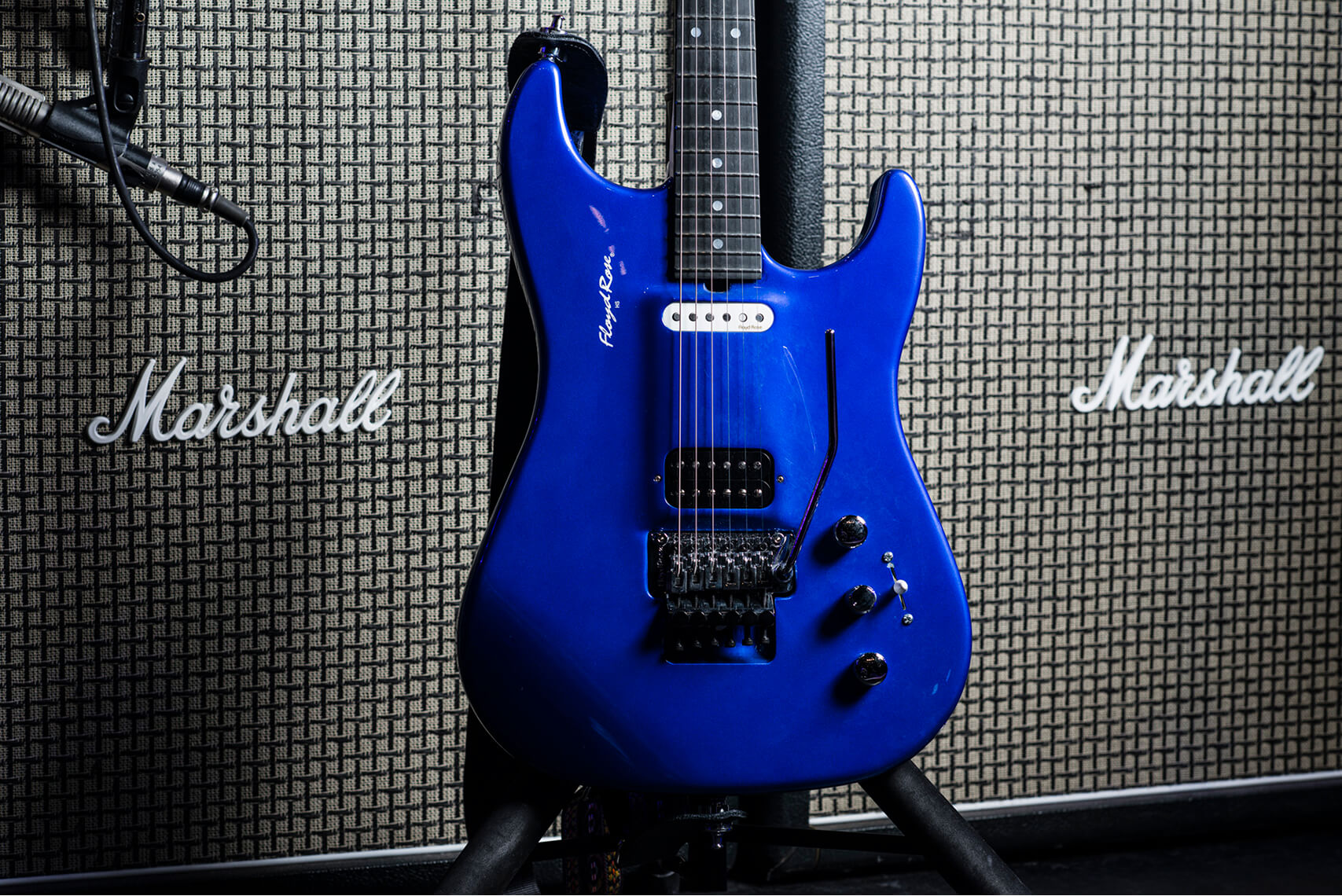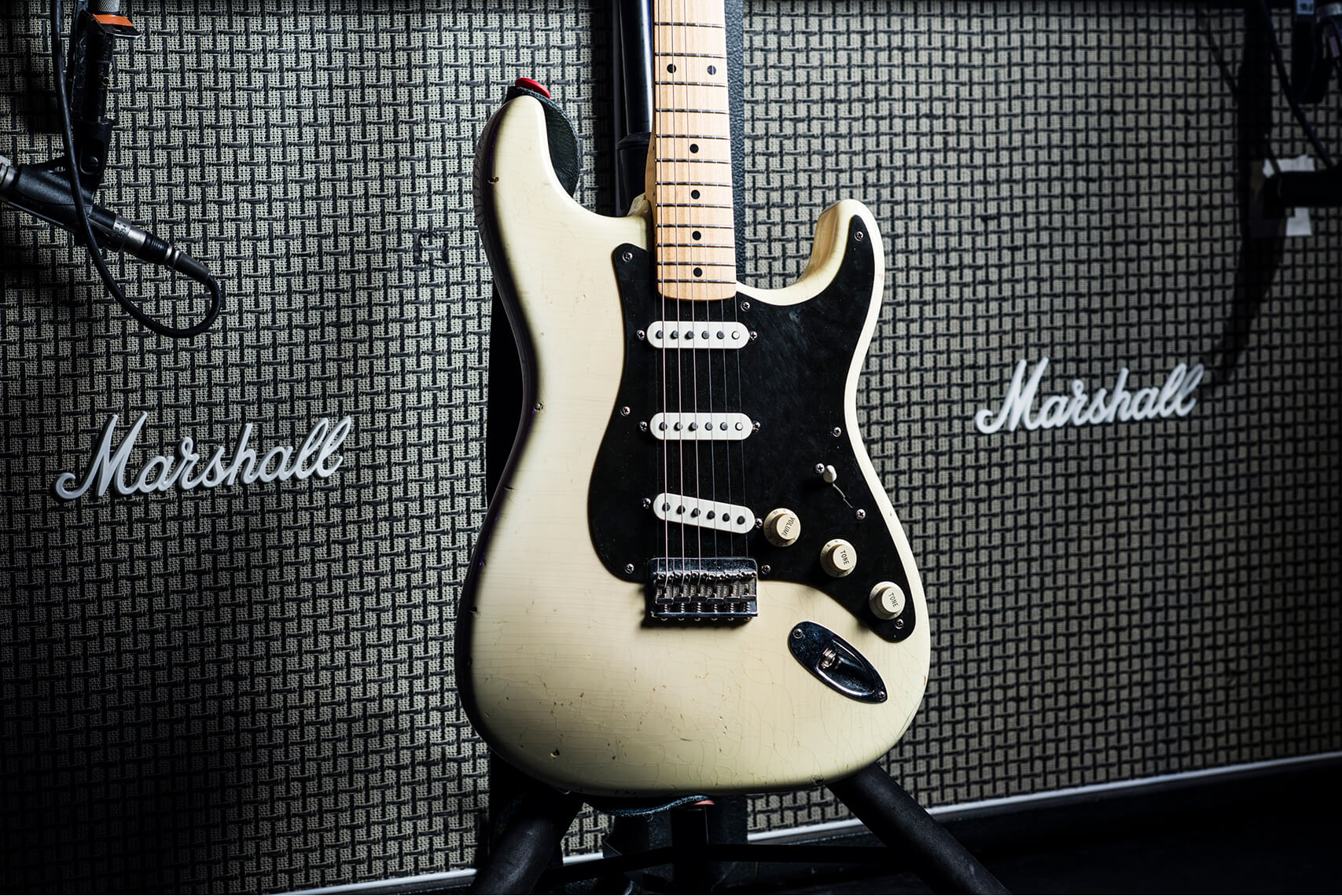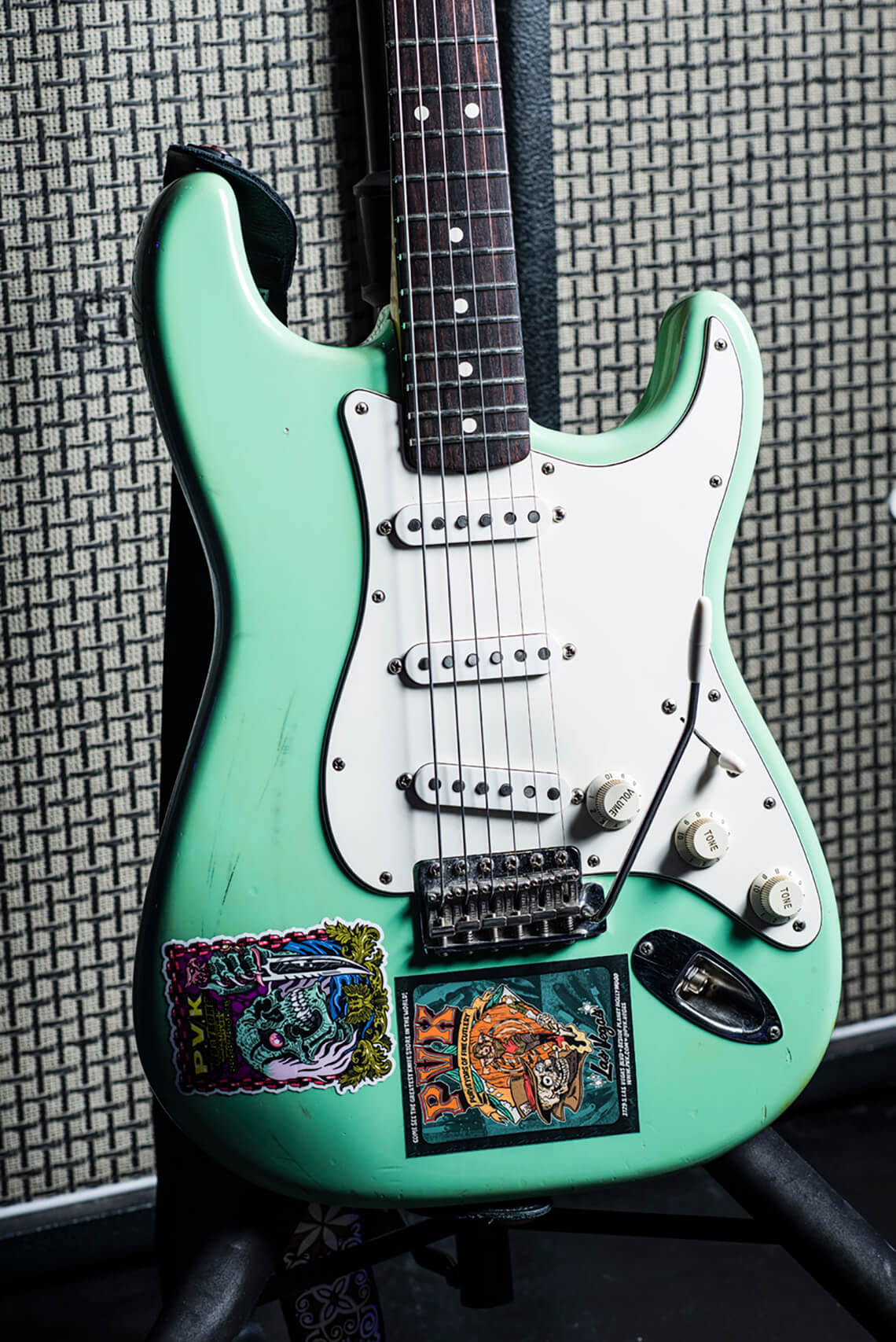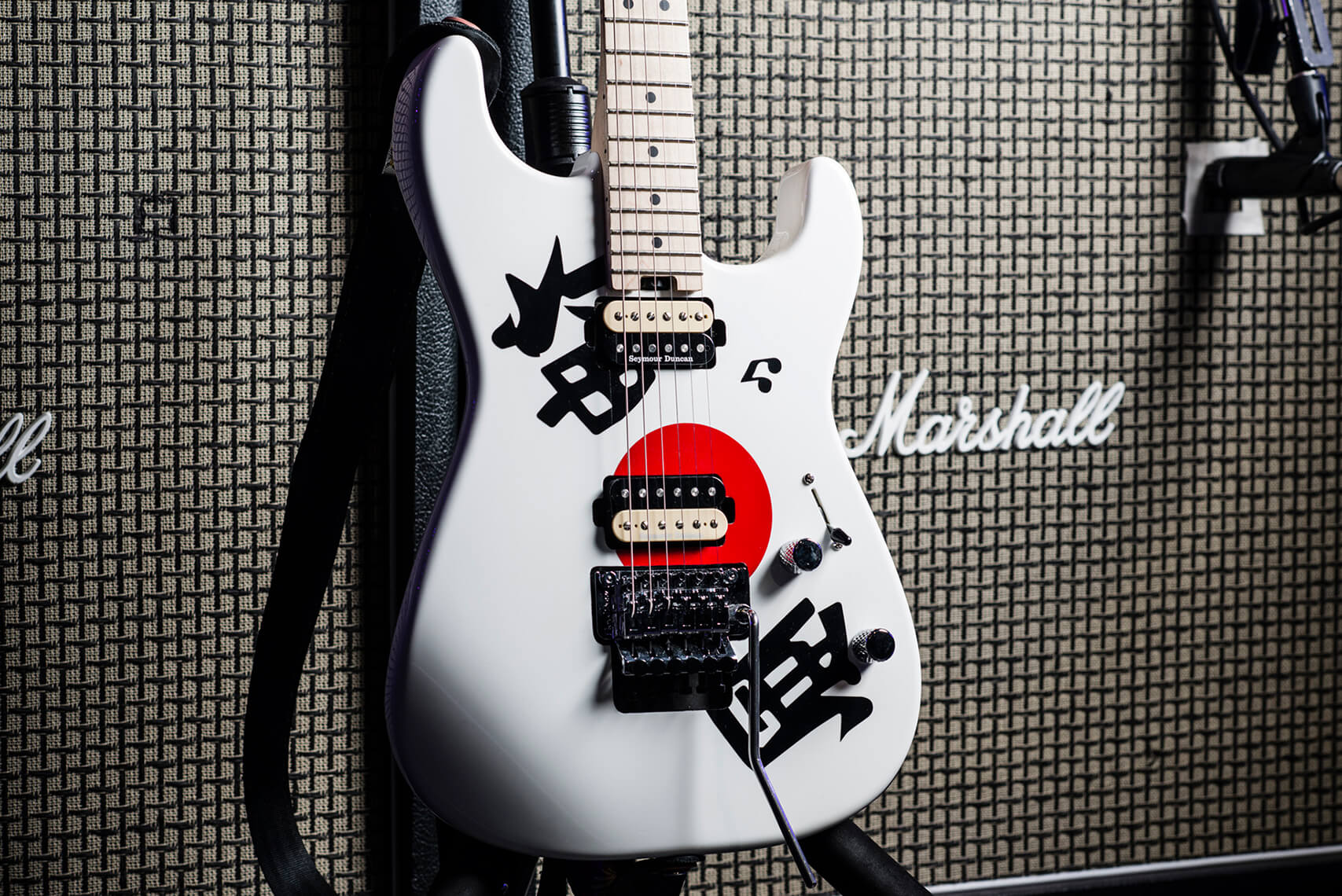Related Tags
Up close with Joe Perry and Brad Whitford’s Aerosmith live rigs
Aerosmith’s Vegas residency has given Joe Perry and Brad Whitford the opportunity to experiment with their smorgasbord of gear. We talk to their guitar techs to find out about the special sauce.

Joe Perry’s almighty amp rig is a thing of beauty
Before the photo session, before the interviews, before the rock ’n’ roll masterclass we receive while witnessing Aerosmith live in concert, we meet Marco Moir and Greg Howard. As the guitar techs for Joe Perry and Brad Whitford, respectively, it’s Moir and Howard who keep the six-stringers – and the show – ticking over night after night.
Moir has been with the band since 2010. He began as Whitford’s tech before moving over to work with Perry a few years later. He’s excitable and eager to give us as much of a rundown of the guitarist’s gear as time will allow. Ushering us backstage, he walks us around to his stage-left tech station and then out to an imposing sight – Perry’s monolithic wall of amplifiers.
A centre column of Supro and Friedman cabs is flanked by two rear-facing Friedman heads atop four Marshall pinstripe 4x12s. The bottom two cabs are of the tall Hendrix-style variety, while the top two are standard angled models that are oriented upside-down. What advantage this configuration offers isn’t immediately clear and, while Moir isn’t willing to unravel the mystery for us, he agrees that it looks cool.
In an array of oversized road cases next to the Marshalls sit a few small Supro amps, all mic’d and isolated from stage volume. The stage rig also features a refrigerator-sized case full of Fluke decibel meters and Veeco gauges beneath a green-and-black readout. The tower is tall and intimidating, like some sort of supercomputer.
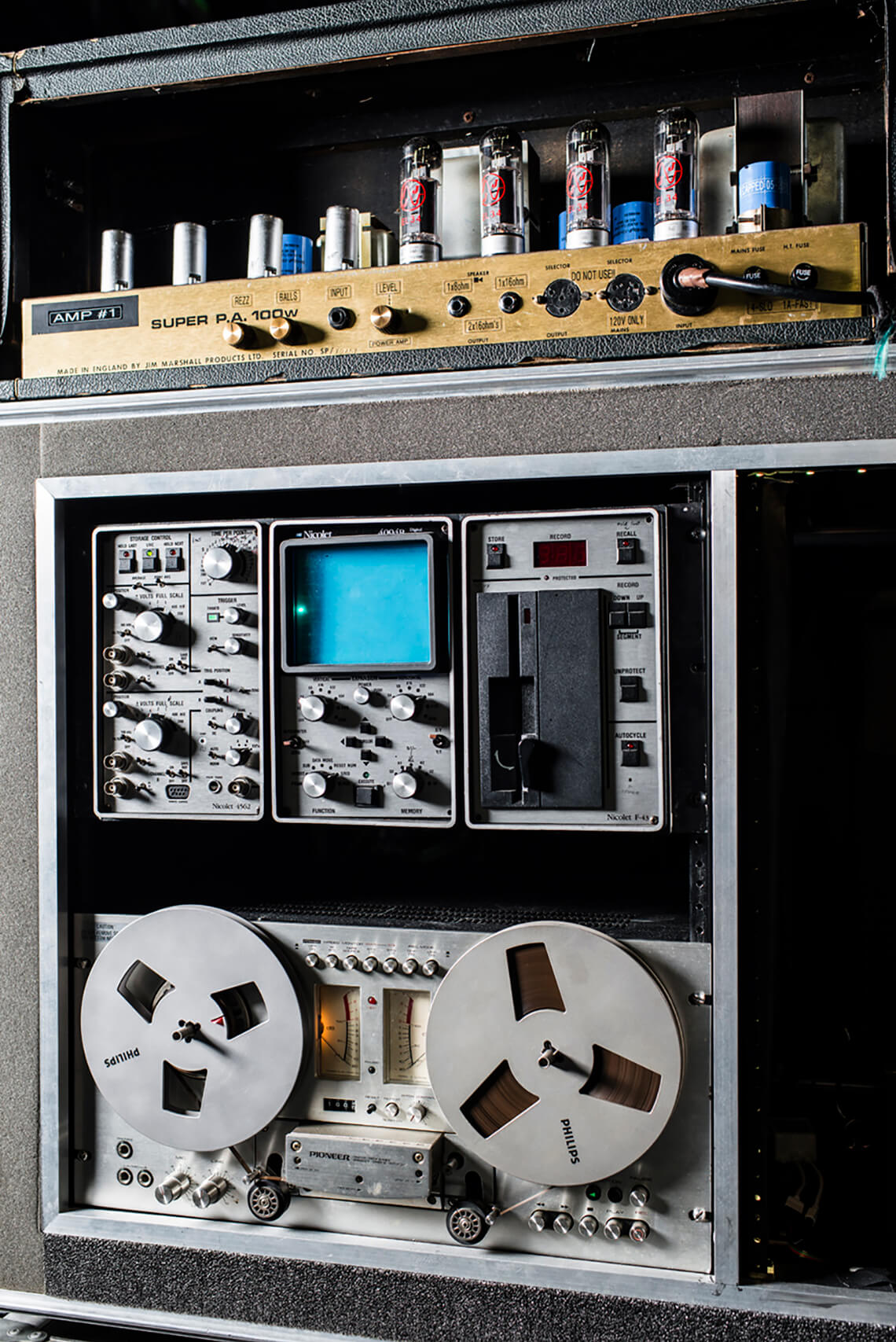
To the left, there’s an oscilloscope and a reel-to-reel tape machine performing some indiscernible and presumably indispensable task. Unsurprisingly, these are also shrouded in secrecy – what Moir knows, he isn’t telling. Mysteries abound; the mental notes are stacking up.
One secret he is willing to discuss is the curious footswitch tucked away between the amplifier stacks. It’s hooked up to a tiny amp above, what appears to be an Alessandro Bone Yard stripped of its livery. Whatever it is, it’s cranked all the way up and connected to a single speaker of one of the 4×12 cabs.
Its purpose? So that Perry can walk up to that cab, hit the switch and be greeted by easily controllable feedback at moderate volume. It’s a brilliant solution for a sound meant as punctuation rather than a peal. In a venue such as this, having the rig constantly cranked for feedback could become problematic.
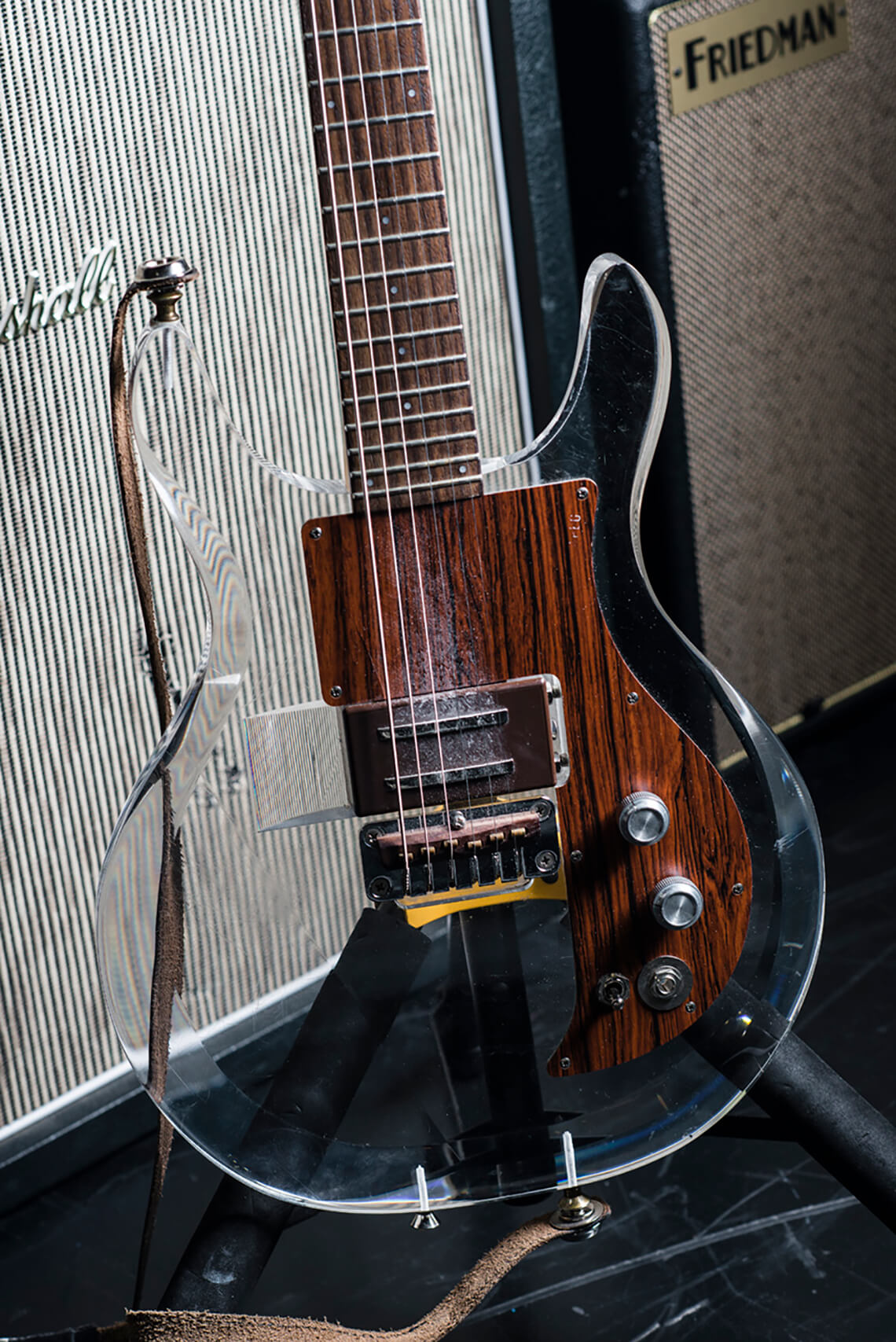
Foot stomping
Full disclosure: try as we might, we couldn’t fully unravel the deep mysteries of the Massachusetts-born rocker’s signal path – and it wasn’t for lack of trying. We’ve been sworn to secrecy on a few matters, too, but there are a few things we’re allowed to show you.
Near the front of his chain, Perry employs a SoloDallas Schaffer Replica, a legendary preamp that recreates the sound and response of the Schaffer–Vega Diversity System wireless units of the 1970s, long touted as the secret to Angus Young’s blistering guitar tone.
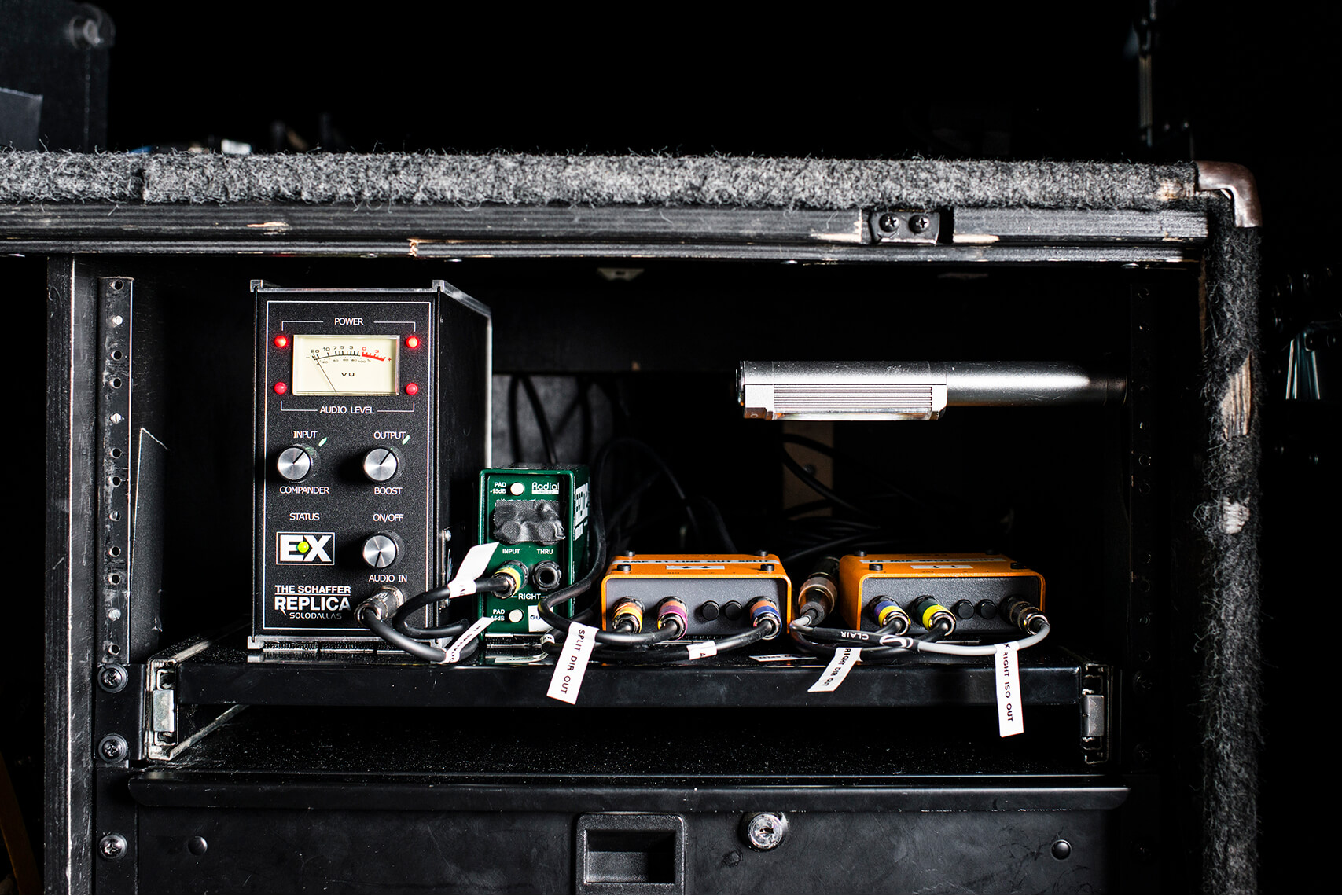
The bulk of Perry’s effects are stored in drawers backstage and linked up to an enviable Bradshaw switching rig, a set-up that leaves the stage relatively uncluttered. In those cabinet drawers are delights such as the MXR Ten Band EQ, a DryBell Unit67 compressor, Gamechanger Audio’s Plasma distortion unit, and a J Rockett Audio Designs Archer overdrive pedal.
For modulation and pitch, there are DryBell Uni-Vibe and Vibe Machine pedals, a Tsakalis Audio Works Phonkify envelope filter, a big box Electro-Harmonix POG, a Fulltone Ultimate Octave, and a Diamond Tremolo. Delay and echo comes courtesy of the Dunlop Echoplex Delay, Wampler Faux Tape Echo, and the Strymon Volante.
At Perry’s mic station is a sparse pedalboard with a bank of switches for his most-used backstage effects, although he has a few pedals up there as well. On the board, you’ll find a fifth-generation Digitech Whammy, an MXR Boost/Line Driver, a Real McCoy Custom wah, and various tap tempo switches for his time-based effects. There’s a cup filled with mints on the mic stand, presumably to keep Perry’s playing fresh. When you gotta chew, you gotta chew.
Reverse engineering
Joe is a big fan of upside down S-type guitars built by Bruce Nelson. Each of the Aerosmith guitarist’s California models feature reverse bodies and necks, left-handed MannMade vibratos with right-handed arms, and locking tuners. The black one, which Perry christened ‘the Admiralcaster’, is equipped with Joe Barden pickups and is incredibly lightweight. The white Nelson, the very first build Nelson completed for Perry, has a trio of Lollar pickups with an onboard anti-hum system. The natural model sports Fralin Noiseless Stratocaster pickups. All the Nelsons share a modified treble-side cutaway for easier access to the upper frets.
One of the most noteworthy guitars in the rack is a Gibson Custom replica of Joe’s storied 1959 Les Paul Standard. As the story goes, he sold his original tobacco-hued Burst in the 1970s and lost track of it until 1984, when its then-owner Eric Johnson offered to sell it back to him. But Perry, without the cash, had to decline. He rediscovered the guitar in the hands of none other than Slash five years later, in 1989. Perry bugged Slash to sell it for years but to no avail. Then, on Joe’s particularly happy 50th birthday in 2000, the top-hatted one presented it back to him as a gift.
The guitar pictured here is replica #001 of that Les Paul, Tom Murphy-aged and showing off distinctive wear around the neck-volume control and a lovely reverse chevron top. It’s a stunning piece with a beautifully checked finish, aged hardware and a few key gouges in the top, just like the original.
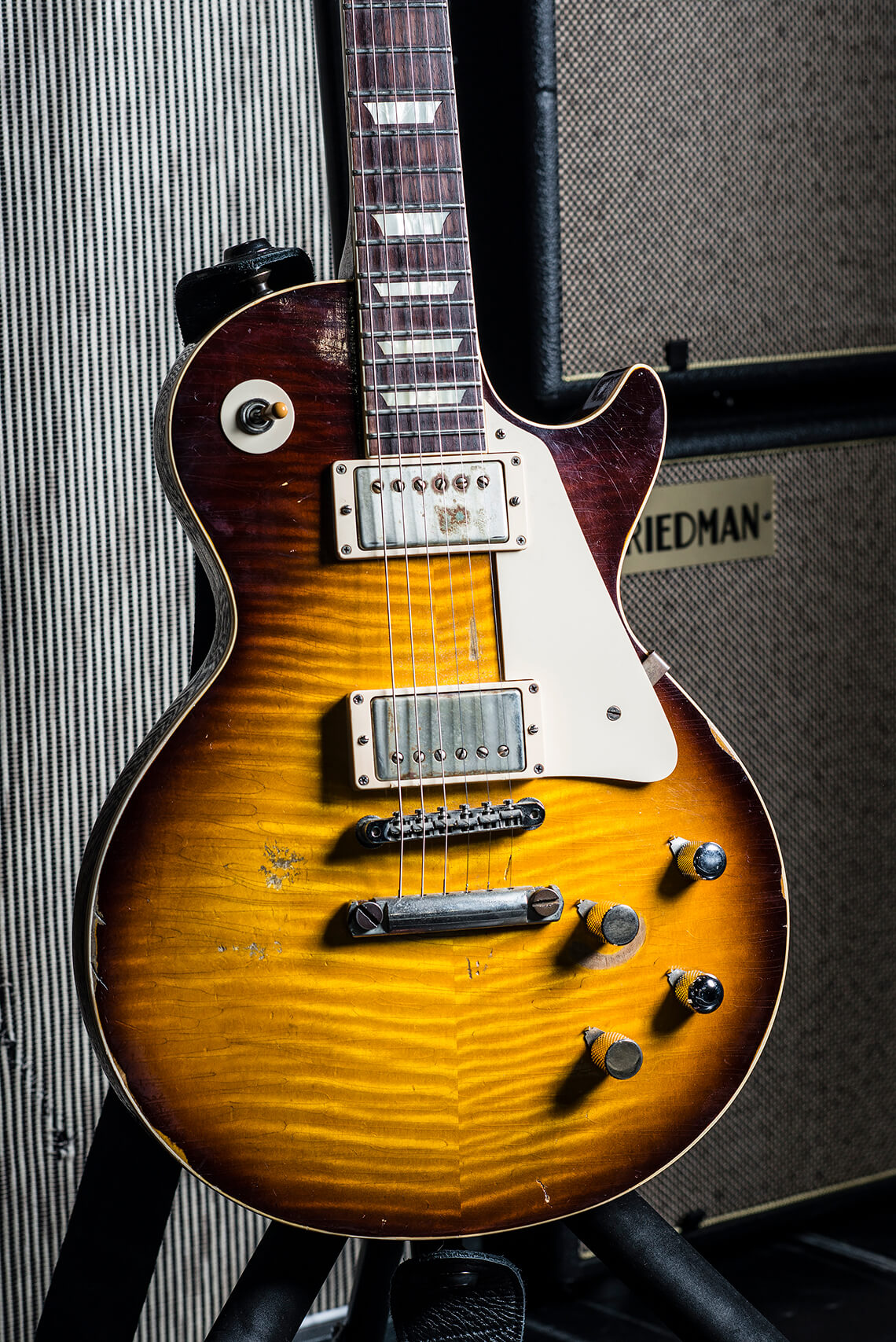
We couldn’t move on without mentioning ‘Billie’, the custom ES-355 painted with front and back-facing portraits of Billie Paulette Montgomery, Joe’s wife of 35 years. The guitar has no f-holes, a simplified volume and tone control layout, and hot pickups specifically wound for Perry. This guitar appears to have a white base colour but, upon closer inspection, it’s actually a beautifully iridescent pearl.
Perry also wields two of his Gibson Les Paul Axcess signature models these days: one in black, the other in Gold Rush. These stripped-down LPs feature a single 498T humbucker pickup, simplified controls for volume and a coil-split tone knob, a roller nut, and a Strat-style Wilkinson vibrato. They’re light and wildly resonant guitars.
Other interesting pieces in the collection include Perry’s Kurt Hendrick-built custom Cloud Nine guitar loaded with Seymour Duncan P-Rail pickups with special switching for selecting either unit, as well as the active coil. Perry also has a P-Rail-equipped MOE (Made On Earth) guitar customised with the artistic rendering of Aerosmith’s former road manager Mark Lehman originally found on the side of the band’s first touring van. Lehman is referenced in the song Mama Kin – “bald as an egg at eighteen” – and his likeness and the van are both on display at the show.
Perry uses a drop-D-tuned Danelectro 59 12-string on the song Seasons Of Life and brings out the Dan Armstrong for Let The Music Do The Talking, the opening number at tonight’s show.
Monkey business
On the other side of the stage sit Whitford’s amplifiers and, behind them, Greg Howard. Alongside designer Ossie Ahsen and Whitford himself, Howard is one of the titular primates of the 3 Monkeys amplifier company. The firm creates incredible-sounding amplifiers – if you haven’t experienced one for yourself, we highly recommend it. Whitford’s input has been invaluable in creating that sound, so it’s doubly interesting to finally hear one in its most foundational context.
The main components of Whitford’s stage rig include the following: on one side, an Ahsen-built 3 Monkeys Orangutan Pro head running a pair of 5881 power tubes in place of the usual quartet of 6V6s, as well as larger output transformers. On the other is a new, entirely stock Magnatone M-80 Super Fifty-Nine head that Whitford refers to as a “perfected 50-watter”.
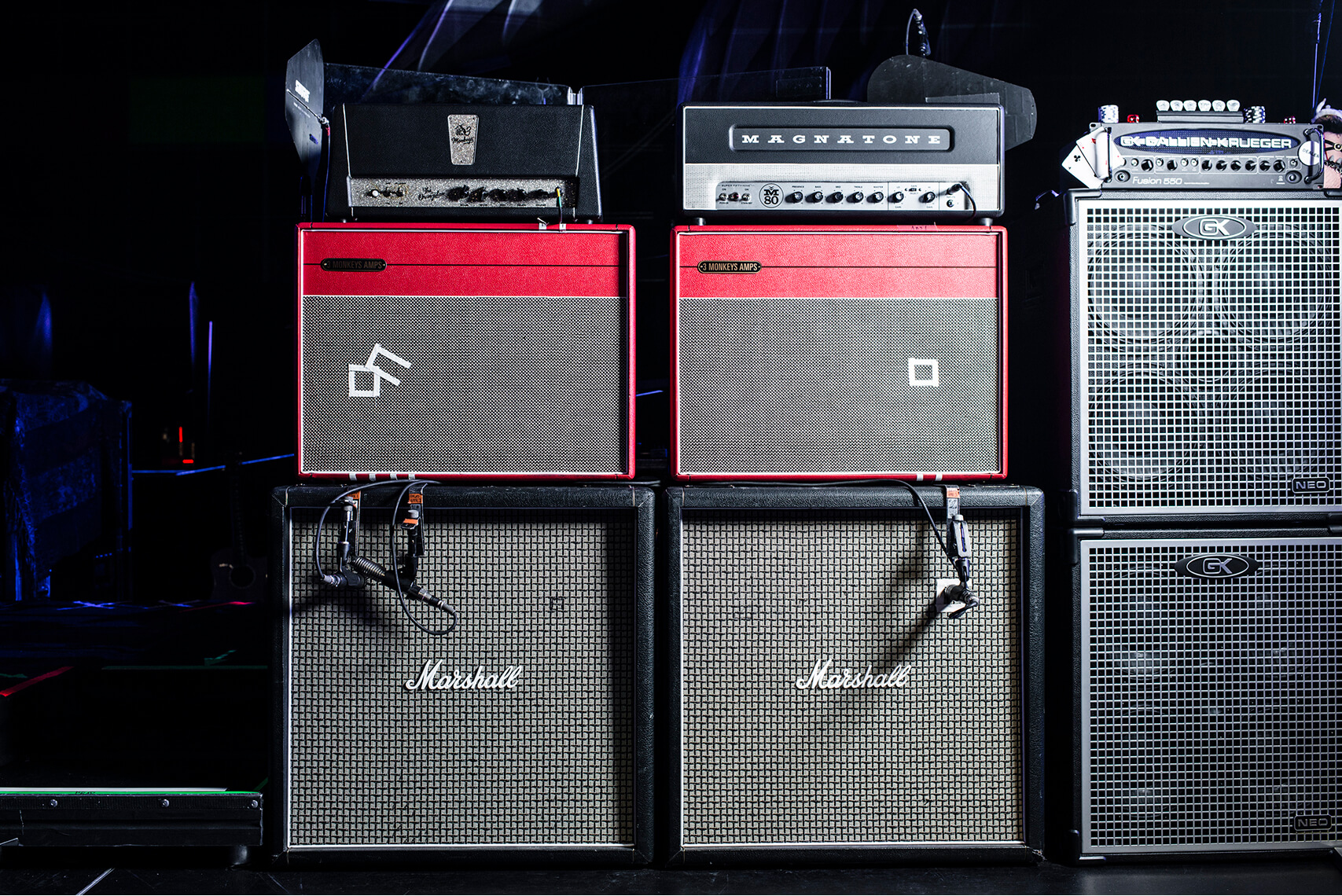
Each head runs into its own matching chequered Marshall 4×12 loaded with Celestion Greenback speakers. The two red Twin-sized 3 Monkeys 2×12 cabs are loaded with mismatched Celestion speakers: one Ruby alnico and one Greenback in each open-backed cabinet.
While Whitford’s amplifier set-up is far simpler than Perry’s, he employs a bank of pedals to augment his sound. From his Shure AD4D wireless system, his guitar signal goes to an interface box custom-built by Howard, of which he says, “it allows us to run wet effects either in front of the amps or through the effects loops without unplugging anything”.
Whitford’s pedalboard is populated by a number of interesting effects. For drive and compression, there’s a silver Klon Centaur and the “always on” DryBell Unit67, which is essentially a classic 1176 Compressor in stompbox format. For boost, there’s KingTone’s The Duellist, and a Vick Audio 73 Ram’s Head for Gilmour-style solo sounds.
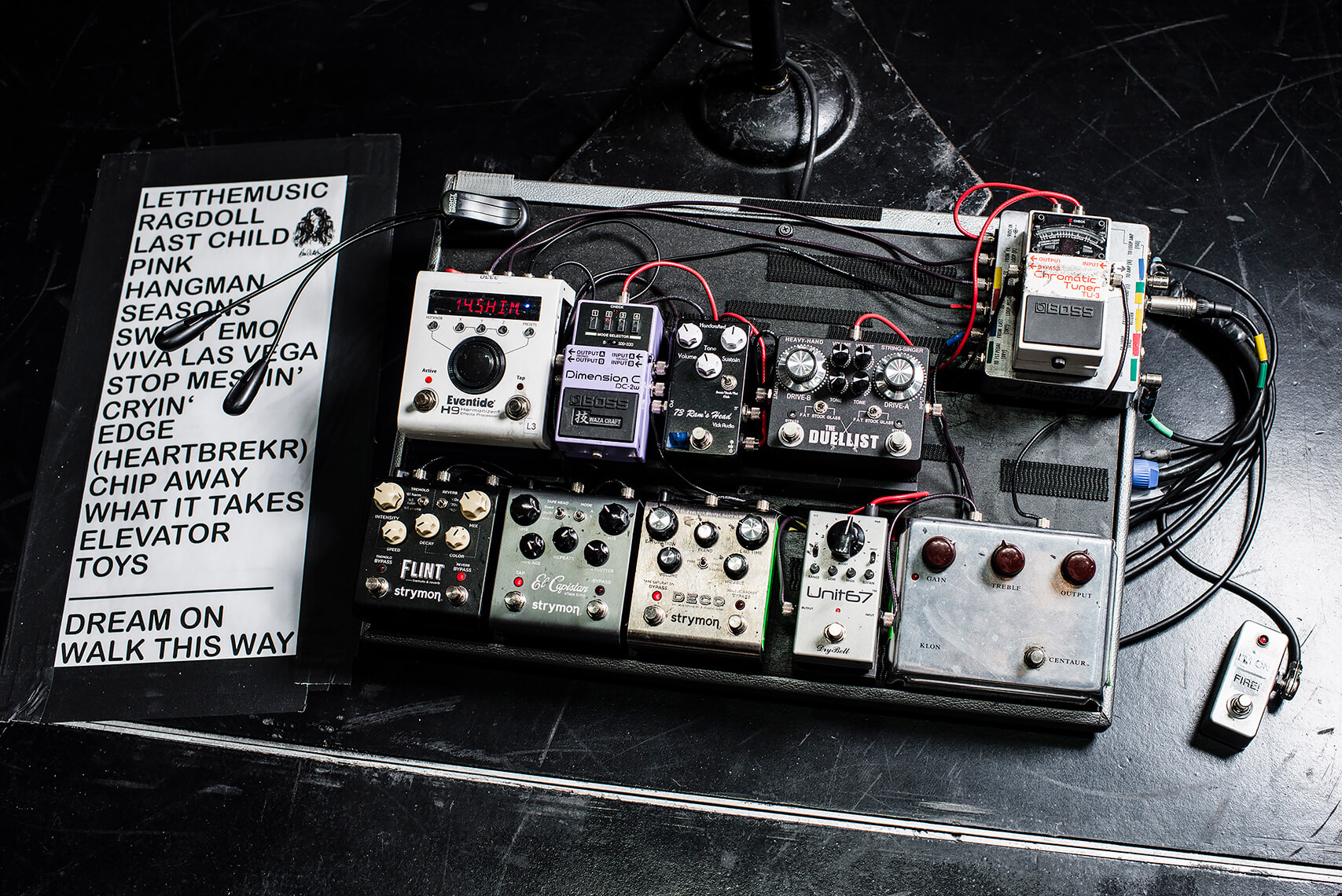
After the boost section are the Strymon Deco and El Capistan for slapback and delay, and a Flint for reverb. After the Flint, all effects run in stereo, including the Boss Waza Craft Dimension C chorus pedal and the Eventide H9, which Whitford uses to add ambience via the modified Shimmer patch. Backstage, Howard controls a TC Electronic Quintessence harmoniser for “about three seconds of the solo in Last Child”.
As you might expect, all DC and patch cables are of the 3 Monkeys Solderless variety, and the pedals are powered by Strymon Zuma and Ojai power supplies.
Oh, wondering about the pedal alarmingly emblazoned with the words “I’m on fire”? Well, that’s not for sound at all. When Whitford steps on that, a red light turns on backstage to let Howard know that there’s a problem out front. “It’s necessary because I’m 20 feet away behind a black curtain,” says Howard. It’s a smart way to get your tech’s attention.
Tools of the trade
When it comes to guitars, Whitford employs a number of enviable instruments. We’ll begin with his main squeeze, a Gibson Cloud 9 Les Paul. The Cloud 9 series was part of a mid-2000s run of chambered reissue guitars in conjunction with retailer Music Machine. Originally this guitar would have come with Burstbuckers but it now sports a set of Ron Ellis PAF pickups with zebra coils.
As for the other Les Pauls in Whitford’s Ultracase, there’s the stunning Gibson Custom Collector’s Choice #28 STP Burst, made to recreate the fabled faded guitar Ronnie Montrose used to record his eponymous 1973 album. The guitar has been modded with WCR Darkburst pickups (wound to Duane Allman specs) and, like other stoptail guitars in Whitford’s stable, is strung top-wrapped. There’s also a 1997 ’58 Reissue Sweet Cherry Les Paul based on George Harrison/Eric Clapton’s famous ‘Lucy’, also with Darkburst pickups and wearing a Bigsby (this is Greg’s favourite of the bunch).
Whitford has a few PRS guitars at the ready, including the 594, featuring new PRS pickups straight from NAMM 2020. There’s also the Silver Sky, of which Whitford is a huge fan. “I play it every night,” he says. “I could literally play the whole show with it if I wanted to. But I’ve got all these other pretty guitars that I like to show off.”
Other notable guitars in the quiver are a NAMM 2020 Guild Aristocrat with a Bigsby vibrato, a Green Guitar Project T-style made of reclaimed wood and graphics designed by Howard, and a Charvel Pro-Mod San Dimas Style 1 that’s a replica of Whitford’s original Japanese flag model, which we’re told now lives in the Hard Rock Cafe collection. The Aerosmith guitarist also slings a new Floyd Rose guitar given to him by Floyd himself.
A quartet of Fenders rounds out the pack. First, there’s a Stratocaster constructed of pine by the Custom Shop and without a truss rod in the neck. A 1985 ’62 reissue Strat in Surf Green, loaded with Dimarzio HB2 and Area 58 pickups, is used for Let The Music Do The Talking and strung with flatwound D’Addario Chromes in DGDGBD tuning. There’s a Custom Shop Heavy Relic Stratocaster that features the same pickup complement, as well as a Custom Shop Clapton model in 7up Green, built specifically for Whitford and using Clapton mid-boost electronics with Lace Sensor pickups.
Check one two
Our time admiring Whitford’s rig comes to an end as each band member’s corresponding tech takes their position for soundcheck. After a quick four-count, the team roars into life with a rendition of Viva Las Vegas – what else?! – which allows all concerned to take a solo.
On any other night, in any other situation, this group of musicians could likely headline any venue they wanted. Each tech turns out to be a top-notch instrumentalist in their own right – a qualification that can’t hurt while carrying out their day job – and the precision and raw talent on display whets the appetite nicely for tonight’s show. It’s an excellent start to an excellent day.
Read our in-depth interview with Joe Perry and Brad Whitford here.


